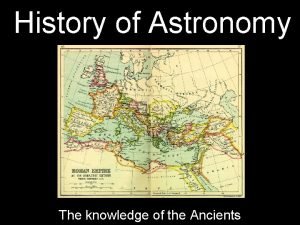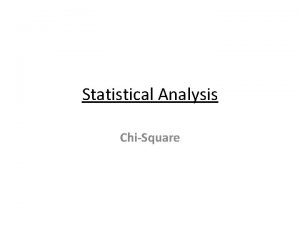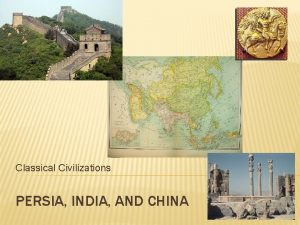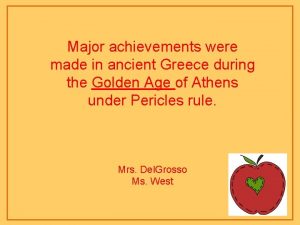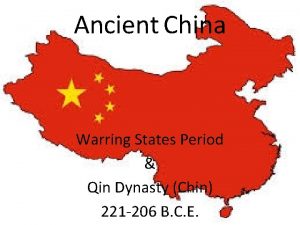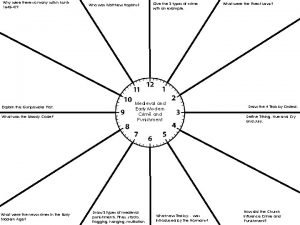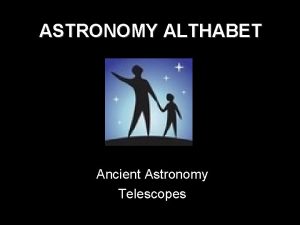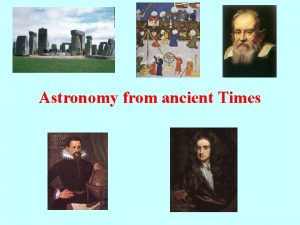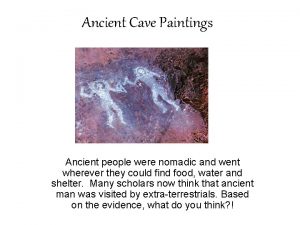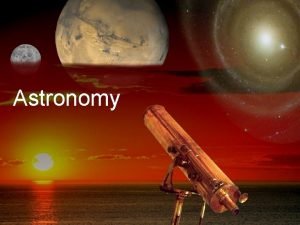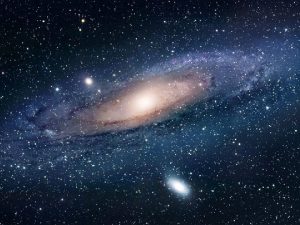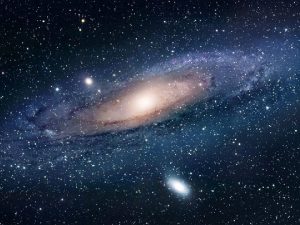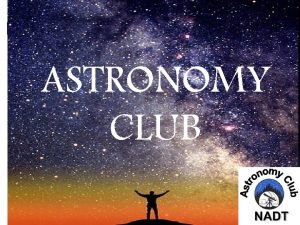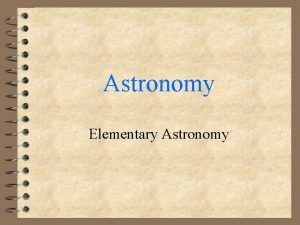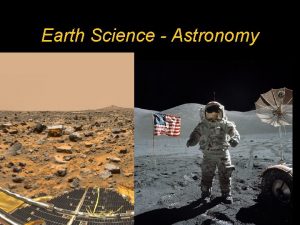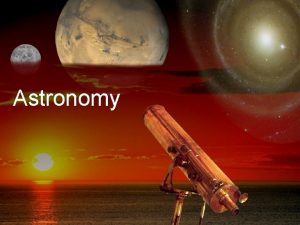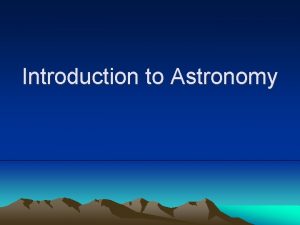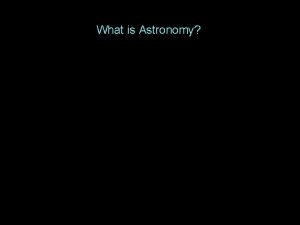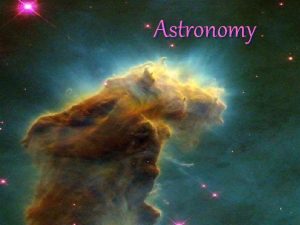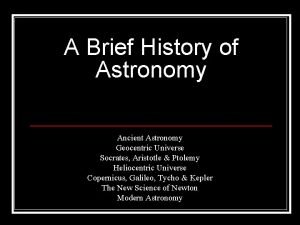Ancient Astronomy Ancient Astronomy Why were ancient people

































- Slides: 33

Ancient Astronomy

Ancient Astronomy • Why were ancient people interested in astronomy – To keep time – To determine when to plant and harvest crops – For navigation – For religious purposes • A big challenge was to understand the systematic and repeating changes that occur in the sky.

Ancient Astronomy • Every day: – The sun rises in the east and sets in the west. – More or less, the pattern of sun motions is the same every day – The pattern of the stars were the same every year. • But note that – The period of time that the sun is above the horizon is not always the same (longer v. shorter days) – The sun is higher in the sky at noon during some parts of the year – The exact point along the horizon at which the Sun rises or sets varies throughout the year – Different star clusters (constellations) rose and fell at different times during the year.

A star that all other stars pivot W N Here’s what they saw in the North E

Celestial N. Pole Here is their thoughts There was a crystal celestial sphere up in the sky with stars affixed to it. Stars are fixed on celestial sphere Celestial Equator Question is – are we rotating or are the stars, sun & planets on the celestial sphere rotating? Celestial S. Pole How could you tell? Celestial Sphere is an extension of our globe

Celestial N. Pole The Other Ultimate Question is with all of this moving stuff - where are we in the midst of all this? Stars are fixed on celestial sphere How can you figure out that too? Celestial Equator Celestial S. Pole Celestial Sphere is an extension of our globe

Ancient Astronomy • Ancient Astronomers: – Thought that the stars and everything in the heavens revolved around us and that we were the center of the universe because everything else seems to be moving, and we were stationary. • Today’s lesson is about the evolution of astronomical thought & theory.

Greek Philosophy & Theory • Universe was perfect – God was perfect • Earth was at center – Earth was the footstool & Gods creation • Inside rotating dome – (celestial sphere) • Introduced Geocentric Model Why do you think they thought this way?

Earth at the Center • In a geocentric system, Earth is at the center of the revolving planets and stars. Basic assumptions: • Planets move at uniform speeds • Planets move on circular paths • We couldn’t be moving – otherwise there would be a great wind. Ask students to describe the movement of Earth and the other planets in the geocentric system. (Earth is stationary; the other planets revolve around Earth. )

Ptolemy’s Model • Noticed retrograde motion If the heavens were perfect, and all the planets were on perfect circles, how could you then explain retrograde motion?

• Introduced epicycles Ptolemy’s Model Clip: Geocentric Motion

Copernican Revolution • 1543 – Nicolaus Copernicus • Able to work out the arrangement of the known planets and how they move around the sun. Developed the Heliocentric model based on Ancient Greek Observations. • Many didn’t accept it – needed more evidence.

Heliocentric Model • In a heliocentric system, Earth and the other planets revolve around the sun.

Retrograde Motion Explained • Geocentric System: • Heliocentric System:

Copernican Revolution • Several other astronomers provided further evidence for the Heliocentric Model: – Galileo • (1564 – 1642) – Tycho Brehe • (1546 – 1601) – Johannes Kepler • (1571 – 1630)

Galileo’s Evidence • 1610 Galileo used the newly invented telescope to make discoveries that supported the heliocentric model.

Galileo’s Evidence • Moon had scars & dimples. – Not everything in the heavens were perfect.

Galileo’s Evidence • The sun had spots – Again, not everything in the heavens were perfect.

Galileo’s Evidence • With his telescope, he discovered: – Four moons around Jupiter • Proved that Not everything revolved around the earth.

Galileo’s Evidence • Venus had phases – Couldn’t get that with w/ a geocentric model.

Galileo’s Evidence • Catholic Church considered it heresy. • Galileo was jailed and later put under house arrest in 1633

Tycho Brahe’s Observations • He and his assistants made much more accurate observations concerning the motion of the planets for more than 20 years.

Kepler’s Calculations • • Tycho’s Assistant Analyzed the years worth of observations Used math to explain motion of the stars. Noticed that the planets do not move in perfect circles, but rather elliptical.

Newton & Hooke Gravity is what governs all of the motion in space.

Einstein Explains Mercury’s Orbit Gravity & the Fabric of Space (& Time) Explains bending of light

Modern Discoveries • Today, we know that the solar system consists of the sun, eight planets and their moons, and several kinds of smaller objects that revolve around the sun.

Modern Discoveries • Galileo used a telescope to observe the solar system – as do astronomers today. • Modern Day astronomers use a series of different telescopes to gain a better view of the universe. • Space Program – Space probes, men on moon etc.

The Speed of Light: light travels at a speed of 186, 000 miles a second or 700 million miles an hour. For scale, the distance from the Earth to the Moon is about 239, 000 miles. This seems pretty fast and indeed theory says that nothing can travel faster than the speed of light.

In our every day lives light seems to travel from one place to another instantaneously. When we flip on the light in a room there is no delay between when we first see the bulb start glowing and when light illuminates the far corners of the chamber. Our nervous systems are much too slow to notice the rays of light that appear from the bulb and move like a wave washing over the room.

When we deal with the immense distances of space, though, even light seems slow. When astronauts were on the Moon it took over a second for the radio waves (which travel at the speed of light) carrying their voices to reach us. Light coming from the sun takes eight and one half minutes to hit Earth. (This means that if the sun were suddenly to go dark, it would take over eight minute for us to notice) Light from the nearest stars, other than the sun, takes four and a half years to get here. From the farthest stars in distant galaxies it can take billions of years for the light to arrive. .

The distance light can travel in a year is called a "light year. " The light year is one of the basic measures of distance for astronomy. When designing probes for trips to other planets in our solar system it is important for the planners to keep the communications time lag, caused by the speed of light, in mind. For example, a probe designed to land on Mars must be smart enough to handle problems in the flight on it's own without instructions from Earth. If a course change is needed during landing the probe would have to do it automatically. The delay caused by the probe requesting instructions from Earth and getting commands back might be nearly an hour, plenty of time for the probe to crash. The delay caused by the speed of light can sometimes be noticed here on Earth during telephone calls. Long distance calls that have been routed over one or more space satellites may cause a half second or so delay between the speaker and the listener.

The distance light can travel in a year is called a "light year. " The light year is one of the basic measures of distance for astronomy. When designing probes for trips to other planets in our solar system it is important for the planners to keep the communications time lag, caused by the speed of light, in mind. For example, a probe designed to land on Mars must be smart enough to handle problems in the flight on it's own without instructions from Earth. If a course change is needed during landing the probe would have to do it automatically. The delay caused by the probe requesting instructions from Earth and getting commands back might be nearly an hour, plenty of time for the probe to crash. The delay caused by the speed of light can sometimes be noticed here on Earth during telephone calls. Long distance calls that have been routed over one or more space satellites may cause a half second or so delay between the speaker and the listener.

The speed of light has several properties which may seem counter-intuitive to us, but are true: -Nothing travels faster than the speed of light. -No matter how fast you are moving the speed of light seems to be the same speed as if you were not moving at all. -As an object or person is accelerated toward the speed of light time slows down for it/him. This last property leads to the "twins" effect: Twin brothers live on Earth. One brother takes a trip to a distant star traveling at a high percentage of the speed of light. When the twin returns he will be younger than his brother because for him time slowed down during the trip. This effect, called "time dilation, " helps explain why the speed of light is the same no matter how fast you are going. As a traveler accelerates time slows down for him. This, in turn, affects his measurements.
 Learning astronomy by doing astronomy
Learning astronomy by doing astronomy Learning astronomy by doing astronomy activity 7 answers
Learning astronomy by doing astronomy activity 7 answers Learning astronomy by doing astronomy
Learning astronomy by doing astronomy Hey bye bye
Hey bye bye Why were ancient greek communities isolated
Why were ancient greek communities isolated Astronomy in ancient rome
Astronomy in ancient rome Don't ask why why why
Don't ask why why why Future in the past continuous
Future in the past continuous How is tom careless in the great gatsby
How is tom careless in the great gatsby Blue people eastern kentucky
Blue people eastern kentucky A random sample of 395 people were surveyed
A random sample of 395 people were surveyed If the world were a village of 100 people
If the world were a village of 100 people People as media and people in media example
People as media and people in media example People kill and people dyin
People kill and people dyin Recovery community
Recovery community Justpeople
Justpeople What is it
What is it The ancient olympic games were initially:
The ancient olympic games were initially: The ancient olympic games were initially
The ancient olympic games were initially Athens cultural achievements
Athens cultural achievements Ancient china people
Ancient china people An ancient people worshipped this golden crop
An ancient people worshipped this golden crop Why were there so many witch hunts 1645-47
Why were there so many witch hunts 1645-47 Why were carpetbaggers called carpetbaggers
Why were carpetbaggers called carpetbaggers How was jack liberated from the shame of self-consciousness
How was jack liberated from the shame of self-consciousness Why were women naturally distrusted
Why were women naturally distrusted Why were viking longhouses smelly?
Why were viking longhouses smelly? Champion of filipino students
Champion of filipino students Why were threats of secession feared?
Why were threats of secession feared? Why did rizal choose morga
Why did rizal choose morga Why isn't kirsti afraid of the soldiers
Why isn't kirsti afraid of the soldiers St lucy's home raised by wolves characters
St lucy's home raised by wolves characters Why were the articles of confederation unsuccessful
Why were the articles of confederation unsuccessful Genesis 15 9
Genesis 15 9





